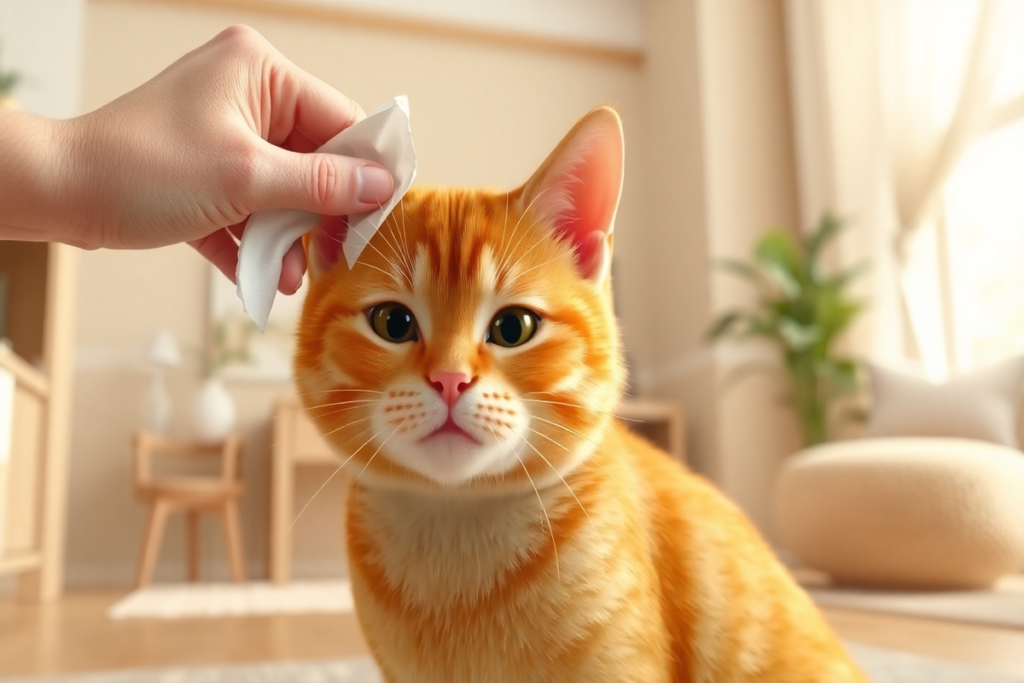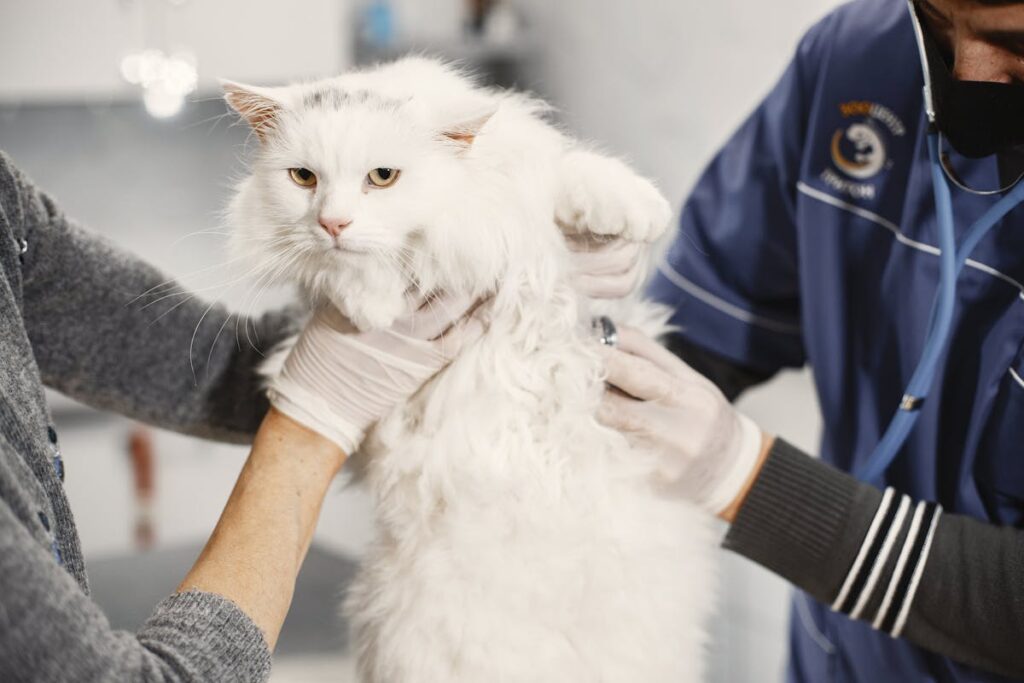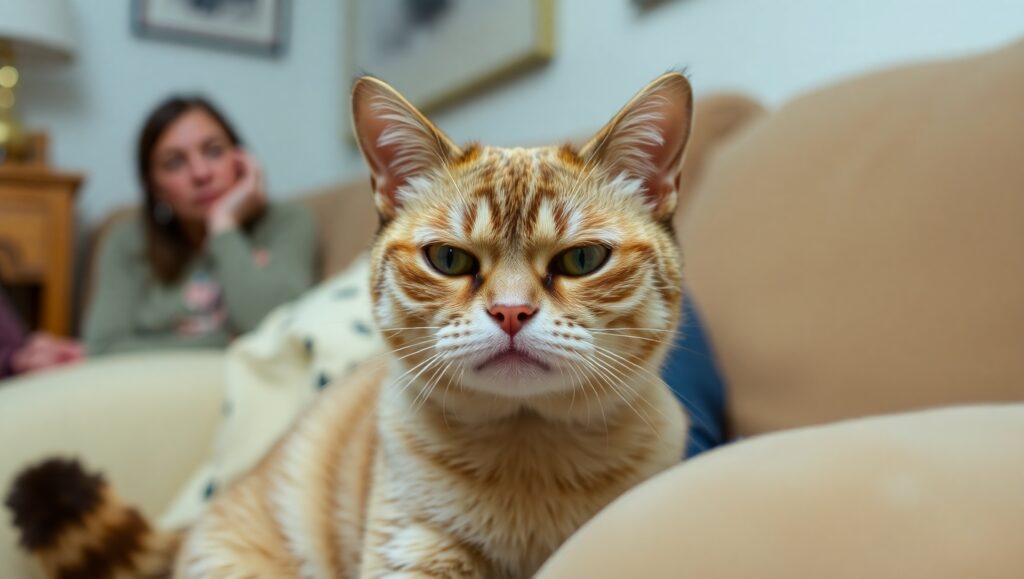Caring for a pregnant cat is not just about giving comfort; it is about meeting her evolving physical, emotional, and nutritional needs throughout all aspects of her pregnancy.
It includes when you first notice her changes; perhaps she is suddenly more affectionate, or her appetite has increased and lasts until the last few days before labor.
Giving proper care during this entire period will help ensure the health of both the mother and her kittens.
If you’re unsure if your cat is pregnant, what you need to feed her, or how to get ready for labor, then you’re in the right place. In this complete guide, we will go through everything from the signs of cat pregnancy and trimester change to parasite prevention, behavior changes, caring for a pregnant cat, and when to call your veterinarian.
Essential Support for Expecting Cats
Cats have a natural ability to deal with pregnancy on their own, and extra attention and support offered during pregnancy could help her and her kittens be more comfortable, decrease health complications, and also help her kittens develop safely.
Providing a wholesome atmosphere with good nutrition, a nice calm nesting area for her to deliver the kittens safely, and regular vet care is crucial. Pet owners can also help outcomes in pregnancy and postnatal care by educating themselves about cats and the different needs and behaviors that may arise.
At the beginning of pregnancy, many cats will grow more affectionate, which is a typical sign of emotional comfort, and they are one of the signs your cat is trusting you.
Understanding Feline Pregnancy
Feline pregnancy can happen surprisingly early; female cats (queens) can go into heat and become pregnant (conceive) as young as 4 months old. If a cat is not spayed and is allowed to go outdoors, she may likely become pregnant, particularly during breeding season.
So, if you suspect that you have a pregnant cat, it begins with identifying early and making decisions proactively. Spaying is a definitive way to prevent unplanned pregnancy and reduce the likelihood of all health risks associated with early-age reproduction and overpopulation.
What’s the Duration of Cat Pregnancy?
The average cat gestation takes 63 to 65 days, or just over two months. Generally, this period is divided into three trimesters, usually just under 21 days long. As the pregnancy develops, you’ll observe some gradual changes in your cat’s behavior, appetite, and physical appearance, especially in the later stages when the kittens are rapidly growing.
It is essential to recognize these changes and adapt your schedule when caring for a pregnant cat. The symptoms a cat experiences earlier on may not be as noticeable; however, by the third trimester, you will probably see some nesting behavior, increased affection/reclusiveness, and the apparent size of the abdomen. Being able to recognize these changes will help you learn to prepare for a safe and smooth delivery.
Stages of Cat Pregnancy: Week-by-Week Breakdown
When caring for a pregnant cat, it is crucial to know what stage of her pregnancy she is in so that you can provide the proper support at the right time. A pregnant cat can exhibit many signs throughout her pregnancy, from early behavioral changes to labor.
Here is a week-by-week guide that tracks your cat’s journey to motherhood.
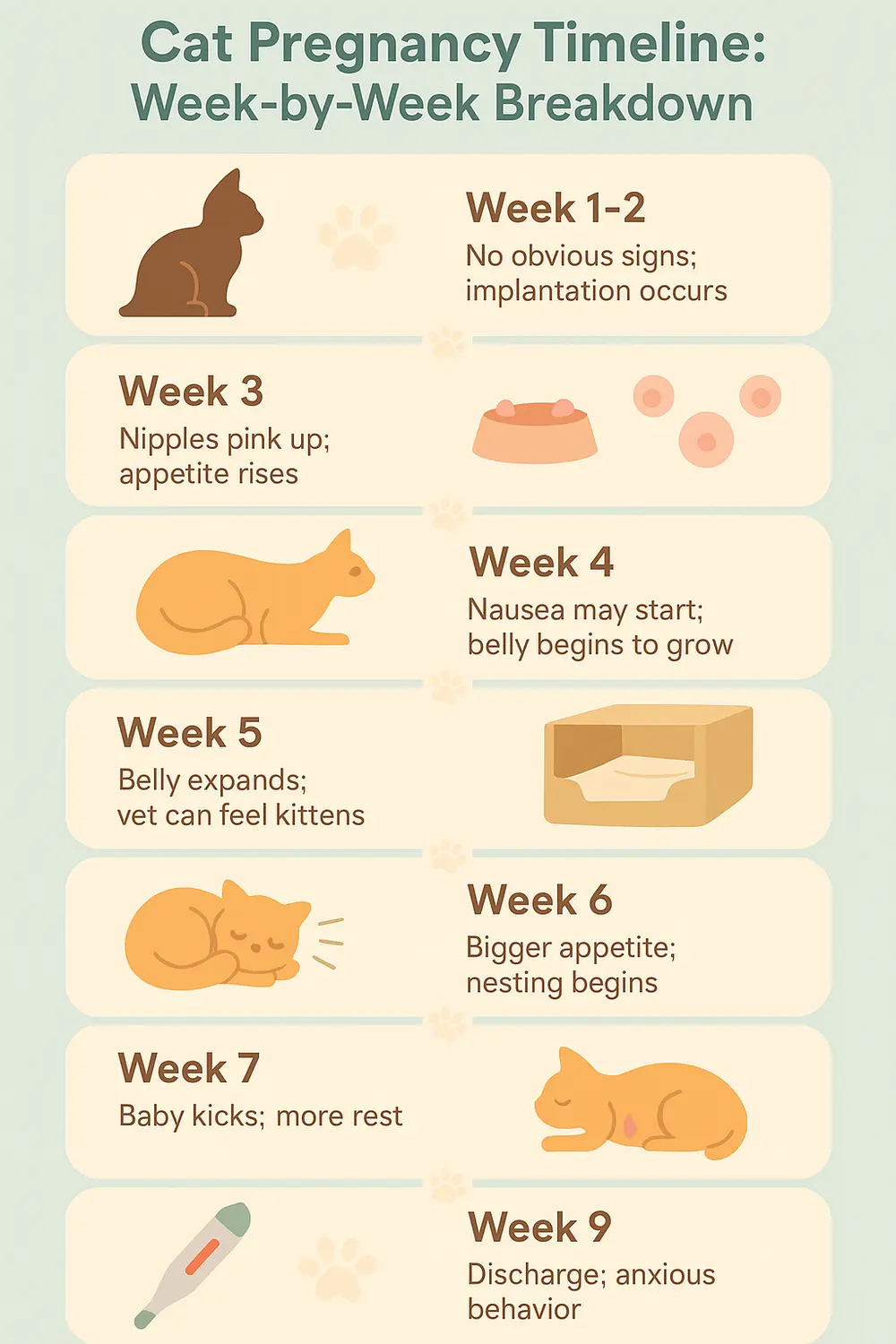
Weeks 1 and 2: Early Physical and Behavioral Changes
During the first two weeks, the changes you will see are very subtle. Your cat may still show heat cycles, and fertilized eggs are usually implanted into the uterus by the end of the second week. Because the physical changes are almost invisible to you, taking care of a pregnant cat includes monitoring the cat and taking it to the vet at this time if you suspect she is pregnant.
Week 3: Appetite Shifts and Mild Growth
As hormone levels change, you may begin to see your cat become more affectionate and slightly hungrier. One key indicator is “pinking,” as in an increase in size and a change in color of the nipples, which become mushy and pink. Keep caring for a pregnant cat by giving energy-dense meals and providing a calm and familiar environment.
Week 4: First Visible Signs of Pregnancy
At this time, morning sickness will likely occur. The cat may vomit now and then and be a little pickier with her food preferences. Her belly will start to look a bit round. A veterinary visit in week four may allow for an ultrasound to help confirm pregnancy. Caring for a pregnant cat now involves monitoring her appetite and not picking her up more than necessary.
Week 5: Noticeable Belly Expansion
Weight gain is apparent. An experienced veterinarian may be able to palpate her abdomen and predict how many kittens you can expect. Do NOT press on or rub her stomach to avoid injuring her. If you’re feeding a high-calorie, kitten-formulated diet, caring for a pregnant cat is essential at this growing stage.
Week 6: Increased Hunger and Nesting Behavior
Her appetite often grows significantly. She may also start nesting, finding a quiet place to prepare for birth. It is part of responsible pregnant cat ownership to prepare a nice, cozy, peaceful area. As much as you can, keep her litter box, food, and water nearby so she is not stressed.
Week 7: Baby Kicks and Extra Sleep
Fetal movements may be observable beneath her fur coat. Your cat may sleep more and may either want your attention or prefer a quiet, alone time, depending on her personality. It will be essential to maintain her routine as consistently and as low-stress as you can. Your role in caring for a pregnant cat includes establishing some emotional reassurance and limiting physical handling.
Week 8: Milk Production Begins
Nipples become more prominent and may exude a bit of colostrum, the first milk. Cats may over-groom, resulting in hair loss around that area, and that is normal. As she nears birth, it is often a good idea to have a clean, warm nesting area prepared for her. Week eight of pregnant cat care allows you to make sure she stays hydrated and has access to food, among other considerations.
Week 9: Pre-labor Preparations
This phase is the final countdown. You may begin to see restlessness, pacing, more grooming, or some mild vocalization. Some discharge, either red or clear, from the vulva is a sign that the cat is close to labor. As the owner’s duty while caring for the pregnant cat, be observant of any signs of distress in your pregnant cat’s behavior, stay near the cat wherever she is, and ultimately be there to provide comfort for her in labor.
Week 10: Delivery Time Nears
While most cats give birth by the end of week nine, it is not unexpected for labor to start in week ten. If there are no kittens after days 67-70, then you should contact your veterinarian. Make sure your cat is comfortable in her nesting area, and be observant for active labor signs such as straining or contractions.
Although a pregnant cat in labor requires supervision, do so gently with patience since they will hopefully give birth within a few hours or less without complications. If difficulties come up, be prepared to involve your vet.
Ideal Nutritional Care for Your Pregnant Cat
Proper nutrition is critical to caring for a pregnant cat. As the kitten develops, a pregnant cat’s nutritional needs go up significantly as their body is supporting multiple kittens. Starting at approximately the fourth week of pregnancy, it will become essential to switch your cat to a high-quality kitten formula diet, either wet, dry, or a combination.
Good nutrition is one of the most essential factors when caring for a pregnant cat. Due to the cat’s body supporting the growth of many kittens, their nutritional needs significantly increase. Here is a detailed breakdown of how to fulfill those needs:
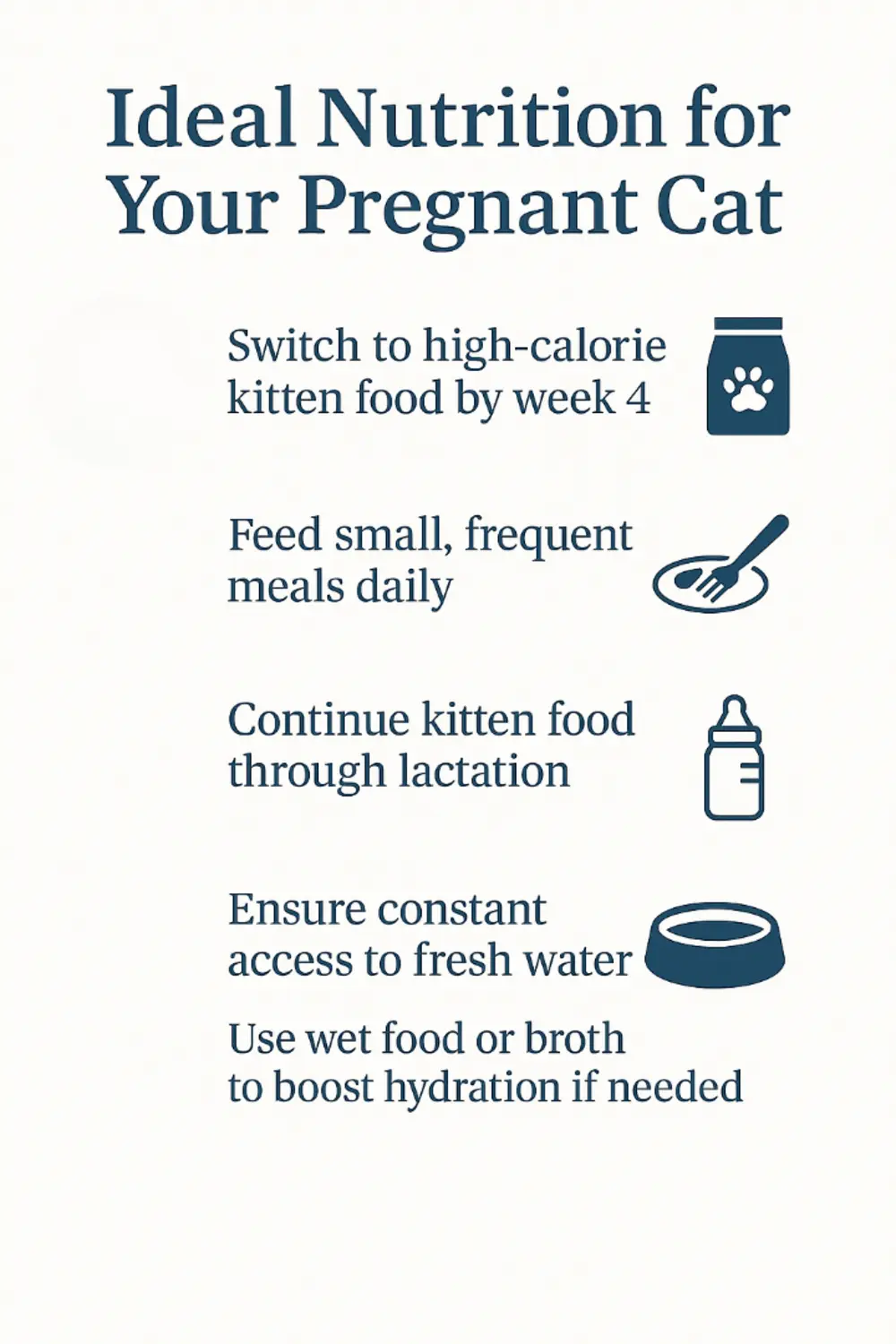
Transition to a High-Calorie Kitten Formula
Approximately the fourth week into her pregnancy, introduce your cat to good quality kitten food. Kitten food, whether dry or wet, is high in calories, protein, and nutrients that will support the development of the kittens and sustain the mother’s strength.
Feed Small, Frequent Meals
When feeding a pregnant cat, consider offering her multiple small meals each day instead of one or two large meals. It will help to avoid stomach discomfort, especially later in her pregnancy, when the kittens are putting pressure on her internal organs.
Maintain This Diet Through Lactation
Continue to feed kitten milk replacer until the kittens are completely weaned, as this results in milk production continuing and allows for post-delivery recovery of the mother. Continuing this care is essential when caring for a pregnant and recently delivered cat and her kittens.
Ensure Constant Hydration
Hydration is essential for a healthy pregnancy. Always provide fresh, clean water in easy-to-reach bowls. If your cat is reluctant to drink water, you can also offer wet food or add a little water or broth to meals for more moisture content.
Continue this high-calorie diet for the duration of her pregnancy and during her lactation period until the kittens are weaned. Provide her with fresh, clean water at all times to ensure she stays hydrated, which is another crucial aspect of caring for a pregnant cat.
You may find out more information about specialized diets for pregnant and nursing cats with these feeding tips to provide the best nutrition.
Top Tips for Caring for a Pregnant Cat
Having a pregnant cat can be an exciting journey, and your careful planning and continued assistance can help ensure a healthy pregnancy and delivery. Here are some essential steps all pet owners should follow when caring for a pregnant cat.
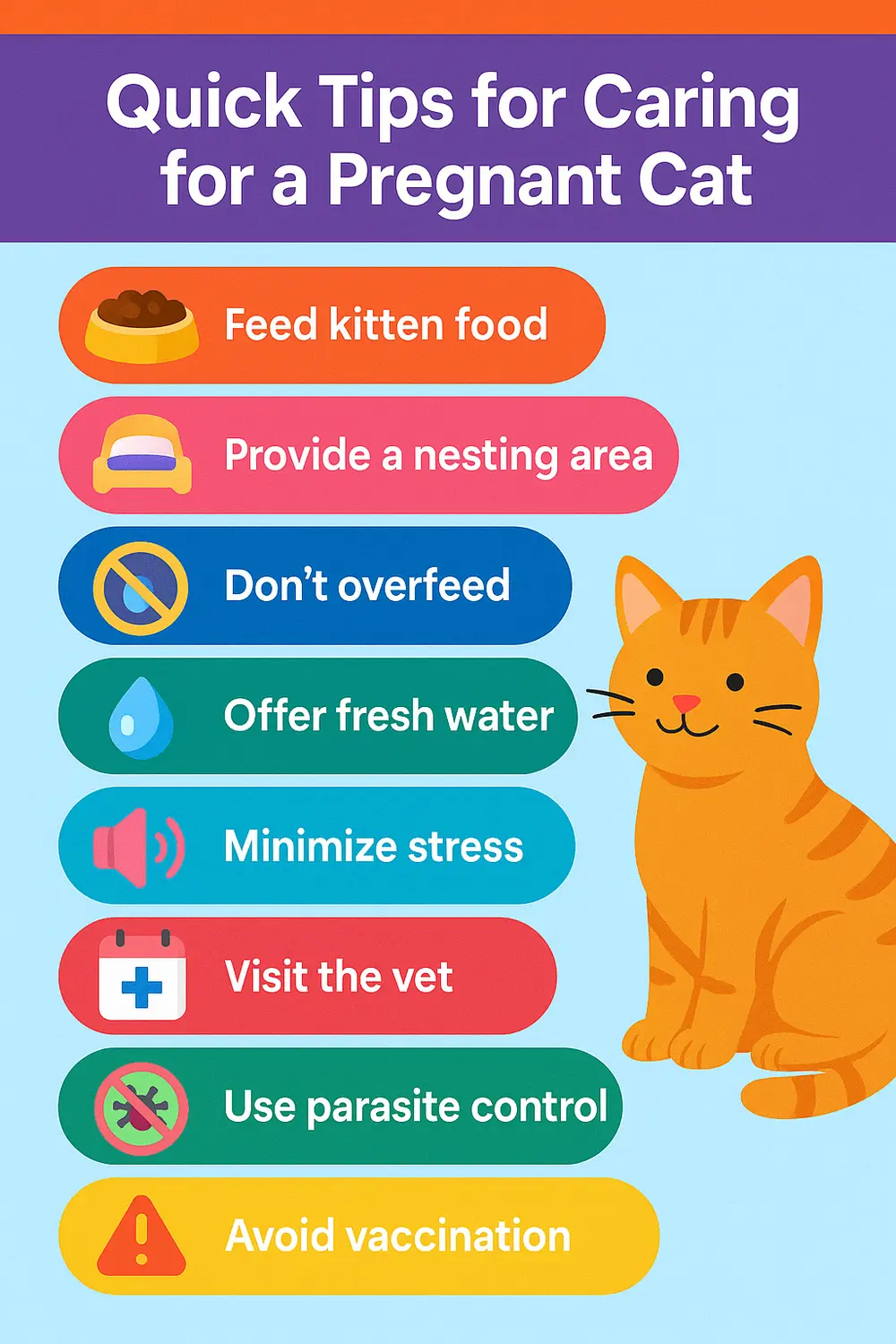
Set Up a Quiet Nesting Zone
As your cat reaches the end of her pregnancy and close to the due date, she will become very vocal and start to look for the best nesting area to give birth to her kittens. Do her a favor by setting up a quiet nesting area ahead of time. Prepare a clean cardboard box or a low-sided pet bed with soft towels or old blankets.
Choose a space in your home away from high traffic noise, kids, and other pets. The stress-free environment will help to reduce anxiety and make your cat feel safe and secure, which is a huge part of caring for a pregnant cat as she gets close to labor.
Avoid Overfeeding
While it is essential that you are meeting your cat’s nutritional needs, overfeeding can cause complications like vomiting or stomach problems. Follow the recommended serving sizes based on your advice from the vet and split this amount up over several meals during the day.
By keeping the feedings balanced, you help to maintain a healthy weight while also making sure that both the mother and the kittens are well-nourished, an integral part of practicing good pregnant cat care.
Minimize Household Stress
Pregnant cats may display increased sensitivity to changes in their environment. It may be best to limit loud noises, unfamiliar guests, and moving furniture during her pregnancy. In the case of other pets, supervise their interactions or physically separate them if necessary.
A calm and consistent home is an essential aspect of emotional well-being and reduces trim items associated with labor-related issues, one of the most underappreciated parts of caring for a pregnant cat.
Keep Up with Veterinary Visits
Regular vet care is an integral part of keeping your cat healthy during her pregnancy. Make sure you schedule regular check-ups with your vet so that you can keep track of the kittens’ development, make modifications to her diet if needed, and deal with any health concerns early on.
Your trusted veterinarian can also help you prepare for the delivery and will be able to provide information and advice on care after birth, vaccinations, and parasite control. There are a few things of value in caring for a pregnant cat, and regular vet care is one.
Vaccination Safety During Pregnancy
When it comes to caring for a pregnant cat, one crucial aspect that needs to be taken into consideration is vaccine safety. In a perfect world, all core vaccines would be given before your cat became pregnant. Vaccination during gestation is generally discouraged, and live vaccines, in particular, can pose extreme risks to developing kittens.
However, killed (inactivated) vaccines may be helpful in some situations, e.g., rabies, and should be used only under the supervision of a veterinarian. If your female cat is pregnant and not vaccinated, your veterinarian may advise delaying vaccination until after the kittens are born and weaned.
Parasite Control for Mom-to-Be
Parasite prevention (fleas, ticks, intestinal worms) is crucial in the care of a pregnant cat, but not all parasite preventives are safe to use if a cat is pregnant. The typical flea preventives such as Frontline Plus are considered safe to use in pregnant cats, but as a precaution, it is always best to check with your veterinarian prior to putting any flea or deworming medications on your pregnant cat.
Moreover, it is advisable to submit a fecal sample that can test for internal parasites. Certain intestinal worms can be passed to kittens via the placenta or during nursing, which could delay the early development of your kitten.
Creating a Comfortable Birthing Space
As your kitty’s pregnancy develops toward delivery, it is essential to establish a safe, quiet, and comfortable birthing space for both the mother cat and her kittens. It is best to start preparing this birthing area during the seventh or eighth week of the pregnancy.
Here’s what to provide for her nesting area:
- A quiet area with little traffic to avoid noise, including any other pets in the household.
- A large cardboard box or covered cat bed to provide warmth and privacy for delivery.
- Soft, clean towels, blankets, or old bedding for her to use for a bed.
- Access to food and water as well as a litter box nearby.
The space should be outside of cold drafts and put in a dimly lit corner and away from disturbances to ensure your cat feels comfortable enough to give birth. Some cats will ignore the place you have prepared and give birth somewhere else, but providing one demonstrates to the cat that you are caring and considerate in eliminating stress from her environment and helping with successful delivery.
Caring for a Pregnant Cat’s Behavior and Mood Shifts
Recognizing behavioral changes is a significant aspect of taking care of a pregnant cat. Hormonal changes can quite change their mood and daily habits. Some cats become extremely social and affectionate and are intentionally butterballs with even more cuddles. There are some who become standoffish or prefer to be alone as their due date gets closer.
Common behavior signs are:
- Increased grooming, particularly of the belly and rear.
- Excessive purring and/or vocalizing.
- Restless with repeated searching for nesting areas.
- Occasional aggression or irritability stemming from discomfort.
Mood transitions are part of a normal pregnancy. Allow for her fluctuating needs and provide reassurance without compelling interaction. Taking care of a pregnant cat is about having a calm, clean, and consistent environment for her to nest in during every stage.
What to Watch for: Illness Signs
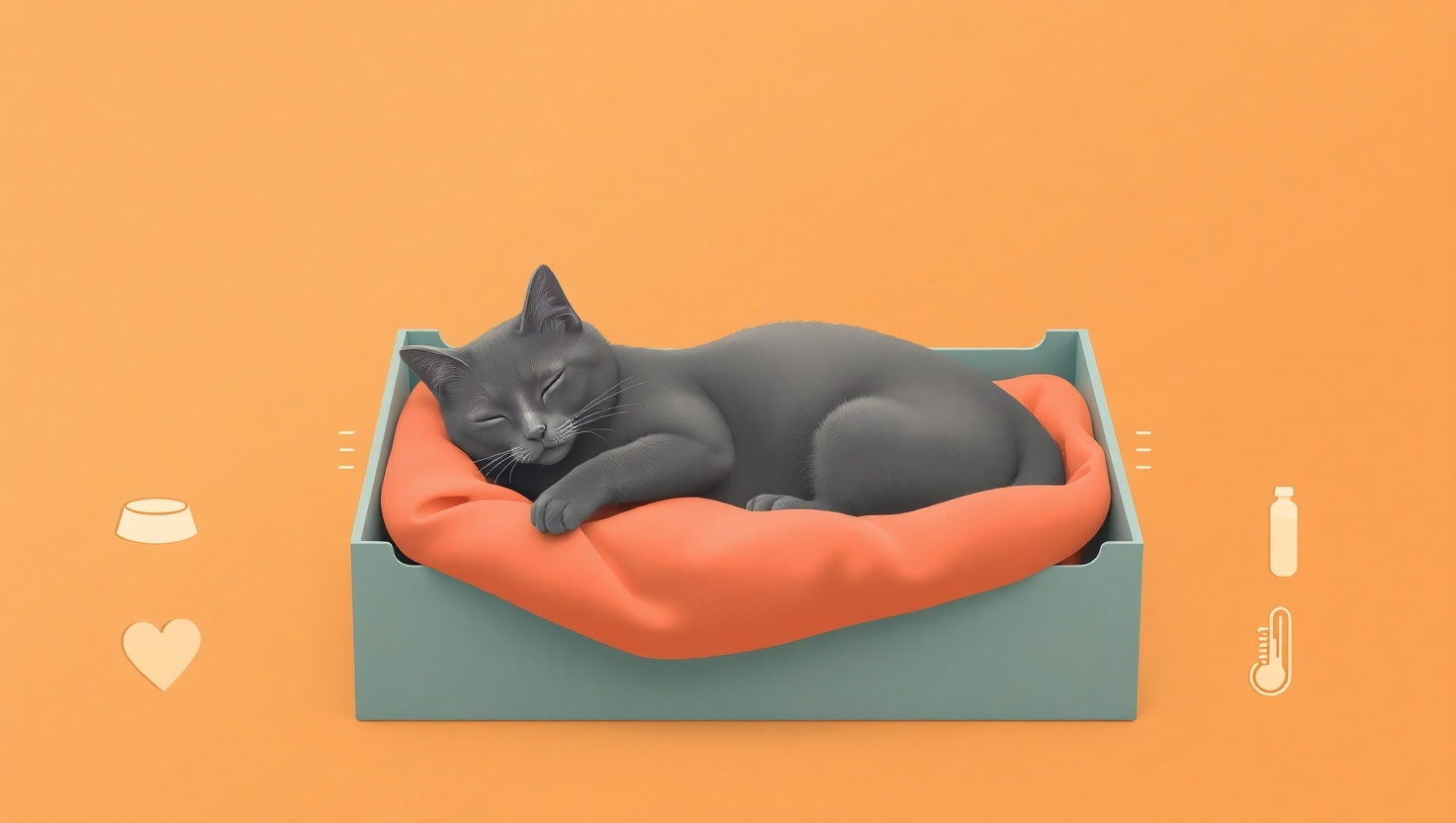
Pregnancy can hide early signs of illness, so close monitoring is essential. Here are signs to be vigilant about while caring for a pregnant cat:
- Lethargy or unusual tiredness
- Frequent or severe vomiting
- Diarrhea lasting more than one day
- Loss of appetite or sudden refusal to eat
- Vaginal discharge, especially bloody or foul-smelling
Make sure to contact your veterinarian if you observe any of these signs. It is essential to seek treatment quickly to avoid complications and protect the health of both the mother and her unborn kittens.
If your pregnant cat is showing warning signs such as vomiting, diarrhea, discharge, or a lack of appetite, they could be warning signs of a sick cat, and you should seek accountable veterinary care.
By implementing these suggestions, you will provide your feline friend with a happy and healthy pregnancy. Your attention in caring for your pregnant cat, from providing good nutrition to ensuring a safe environment, will give her the best chance of a happy, healthy litter of kittens.
Is It Safe to Let a Pregnant Cat Outdoors?
Allowing your pregnant cat outside can be risky, particularly as she nears the end of her pregnancy. In the first weeks of pregnancy, she can likely safely be allowed outside for short, supervised periods, provided she is used to being outside and the area is safe.
However, we would recommend keeping her inside, totally, during the last two weeks of the pregnancy. It will prevent injury and fights with other animals and reduce the chance that she will go into labor in an unsafe area. Remember, part of caring for a pregnant cat is protecting her from unforeseen circumstances that may harm her or her kittens.
How to Estimate the Stage of Pregnancy in Cats
Knowing how far along your cat is in her pregnancy is essential when considering how to care for a pregnant cat. Understanding where her pregnancy is at helps to prepare for the delivery, track her health, and keep the mother and kittens safe. Here are the best ways to determine the stage of feline pregnancy:
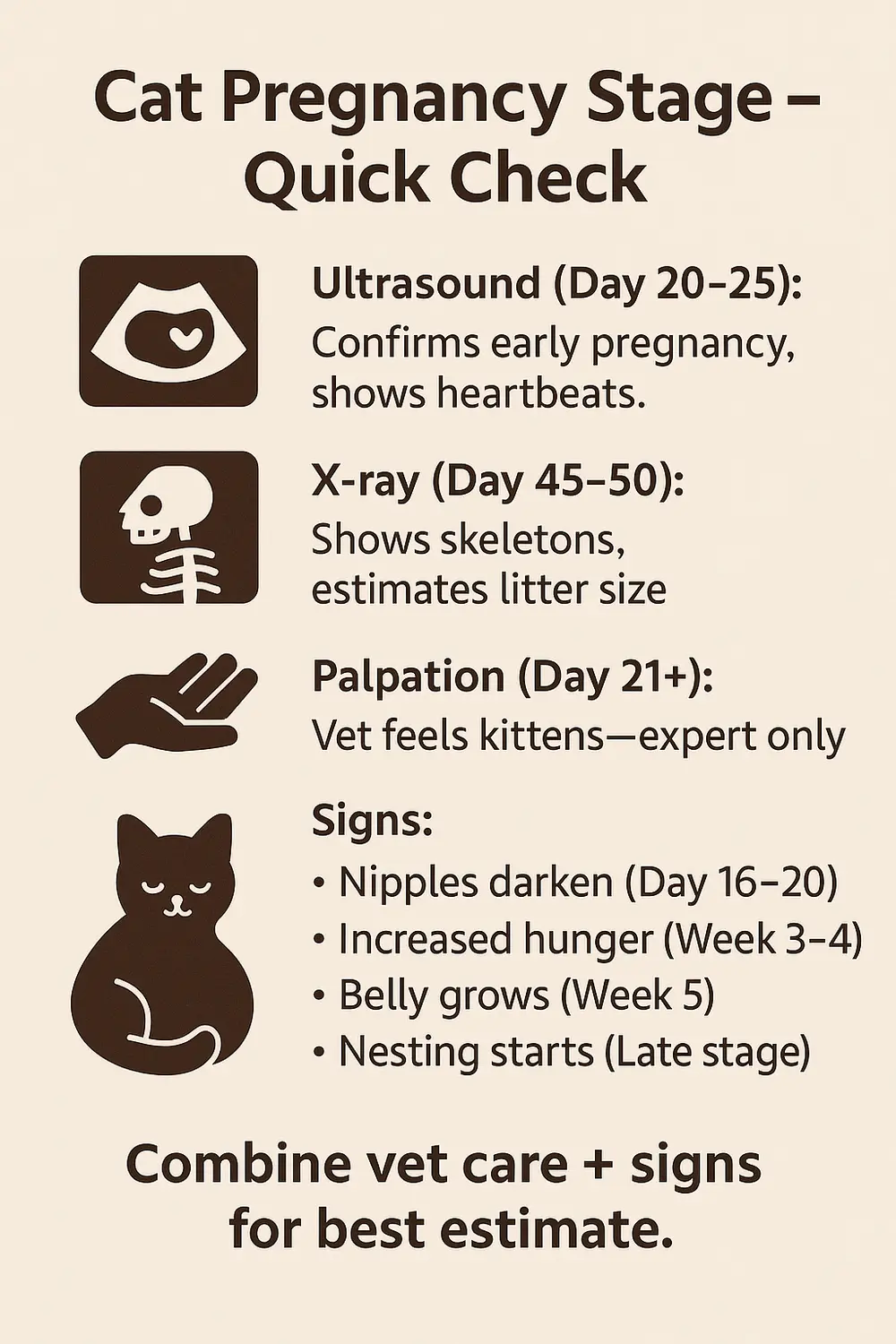
Ultrasound (Day 20–25)
Ultrasound is probably the best way to detect and estimate pregnancy, with the ability to identify pregnancy between days 20 and 25. It can visualize fetal heartbeats, give a little estimate (to a point), and identify pregnancy-related complications. In a pregnant cat, ultrasound is the preferred diagnostic modality in the early stages of pregnancy.
X-ray (Day 45–50)
By around 45 to 50 days, the skeletal structures of the kittens begin to calcify and may be visible via x-ray. An X-ray can help estimate the number of kittens and the stage of development. It is sensible to do an x-ray in the last weeks of pregnancy to anticipate and prepare for birth and to limit surprises.
Abdominal Palpation (Around Day 21)
A qualified veterinary professional can perform gentle palpation of the abdomen and determine if the kittens are developing as early as three weeks (day 21). This process does require skill and should not be attempted at home, as improper handling can be detrimental to the fetuses.
Physical and Behavioral Clues
Changes in your cat’s appetite, behavior, and body condition can provide helpful clues:
- Increased hunger will likely begin around weeks 3 to 4.
- The “pinking” (darkening of the nipples) will happen between days 16 – 20.
- Nesting characteristics will begin in the last trimester.
- You will notice a visible roundness of the abdomen around week 5.
- When looking after a pregnant cat, combining these physical signs with the knowledge of your veterinarian will give you the best approximation for the gestational age.
Knowing how to estimate the stages of pregnancy will allow pet owners to give their best support, prepare ahead of time, as well as help facilitate prompt veterinary attention when required. If you’re not sure, always ask your veterinarian for confirmation and advice.
How to Prepare for Your Cat’s Labor
Appropriate preparation for labor is a significant part of providing care for a pregnant cat at the end of her pregnancy. A calm, safe environment creates a better labor process and decreases stress for the mother.
Set Up a Safe, Comfortable Birthing Box
Prepare a birthing box well before the birth of your kittens – during week seven or eight of the pregnancy would be ideal. You can use a sturdy cardboard or plastic box and line it with soft disposable material, like old towels, fleece blankets, or blankets from the bedding section, but be cautious that there are no loose threads or materials that may tangle around your newborns.
Disposable bedding makes it easier to change bedding, and you can change bedding as often as your hygienic instincts prompt.
Choose the Right Location
Choose a quiet, low-traffic location in your home and set up the birthing box in the most noise-free way possible, away from children and other pets. The area should be warm and draft-free because kittens cannot regulate their body temperature while they are developing in the first few weeks of life. It is best if the room can stay at a temperature of 85–90°F (29–32°C) during that first week of life.
Monitor Without Disturbing
One of the key principles when handling a pregnant cat in labor is to observe but not interfere. Most queens instinctively know how to give birth without assistance from people. It is essential to remain close enough that you can monitor the progress and assist, if necessary if complications arise. Just stay out of the way unless she appears to be distressed and needs your assistance.
Watch for Temperature Drop
In the day or so before labor, your queen’s rectal temperature may dip below 100°F (37.8°C); this is a good sign that she is close to delivering. You can monitor her temperature in the last week of her pregnancy; just be sure that she is okay with gentle handling.
Careful preparation and awareness during this time can have a significant impact on having a safe delivery. Part of the responsibility of caring for a pregnant cat is providing a secure area and knowing when to seek veterinary assistance to help protect the mother and kittens.
Recognizing Labor Signs in Cats
Understanding how to recognize the first signs of labor is an essential part of the care of a pregnant cat. As they get closer to birth, your cat’s body and behaviors undergo some changes that are evident signs that labor is approaching. Ultimately, identifying the primary signs early helps to make sure you are ready to help if needed and know when to notify a veterinarian.
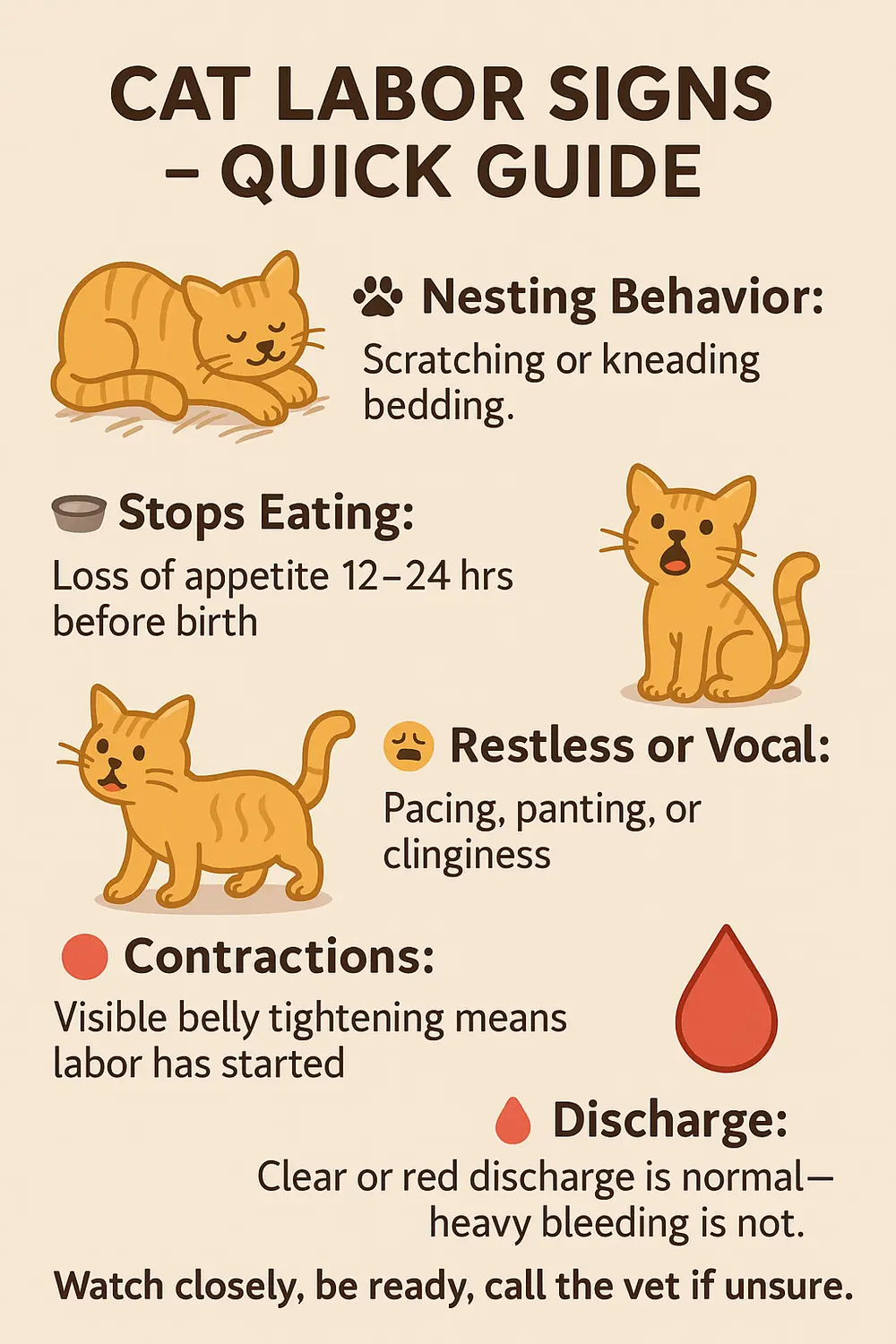
Common Pre-Labor Signs
Pay attention to the following physical and behavioral signs that labor is approaching:
Scratching the Nesting Area
Pregnant cats often start kneading, scratching, or rearranging the bedding in their nesting area. This behavior is instinctual for cats to prepare for birthing by creating a safe and comfy area.
Refusal to Eat
A sudden loss of appetite, especially when accompanied by other signs of labor, usually indicates that kittens will be delivered very soon within about 12 to 24 hours.
Pacing, Panting, or Vocalizing
Restlessness is a sign that a cat may be entering labor. Many of them become very vocal and clingy, while others want to be left alone. Increased vocalization while birthing could be normal. If the vocalization increases, that might indicate some discomfort or signs of distress; find out more about why my cat meows so much.
Severe Abdominal Contractions
If you see significant straining and tightening of the abdominal muscles, you’ve entered the first stage, and the labor of your queen has begun. In this stage, the kittens are entering into the birth canal.
Clear or Reddish Vaginal Discharge
It is normal to have a small amount of clear fluid or blood-tinged fluid in early labor. If the fluid is heavy or smells bad, please call your veterinarian.
Being able to recognize the signs of labor in a pregnant cat promptly is vital. Most cats deliver their kittens without complication, but knowing when to observe closely and when to get help can be the difference between an easy, healthy delivery and one that requires assistance.
When Should You Call the Vet?
Although most cats will give birth without assistance, knowing when to get help from a veterinarian is an integral part of taking care of a pregnant cat. Labor can be prolonged or complicated, which may threaten the health of both the mother and the kittens, so it’s essential to be able to recognize warning signs that something may be wrong.
Call the Vet Immediately If You Notice:
Excessive Vomiting or Complete Loss of Appetite
If your cat has severe vomiting or has not eaten for an extended period of time, particularly later in pregnancy, they are likely sick or possibly in trouble. Both of these require immediate veterinary attention.
Heavy or Bloody Vaginal Discharge
A little bit of clear or slightly pink discharge can be normal. However, excessive, continuous bleeding, especially bleeding with a foul odor, is not normal and could be a sign of an infection or miscarriage, or it may indicate other serious problems.
Contractions Lasting Over 20 Minutes Without Delivering a Kitten
During active labor, there should be strong visible contractions that cause the delivery of kittens, and if you observe your cat straining for more than 20 minutes without any delivery, this could mean your cat has a stuck kitten, or the labor may have stopped; this requires emergency assistance.
More than 3 hours between kittens and not straining
Some cats may take breaks between deliveries, but if after three hours you observe no activity or straining, this could be a sign of labor interruption or fatigue; veterinary assistance can manage the remainder of the litter-safe delivery.
A Kitten Presents As Stuck in the Birth Canal
If a kitten has been dealt a partial delivery and becomes stuck, please do not pull or attempt to help it out. This scenario requires timely veterinary attention so you do not hurt the mother and kitten.
Watching and responding to these red flag signs is a very applicable aspect of caring for a pregnant cat. Taking action promptly could facilitate a smooth and safe birthing experience for your kitty and her babies. If you are looking for credible advice on when to see the vet, visit these veterinary-reviewed cat health topics from Cornell University.
Caring for Mom Cat After Birth
Once the kittens have been born, your responsibilities in caring for a pregnant cat have progressed to caring for a mother cat. Good postpartum care will help to ensure that the mother cat and her kittens recover well and begin their critical early days after birth in good health.
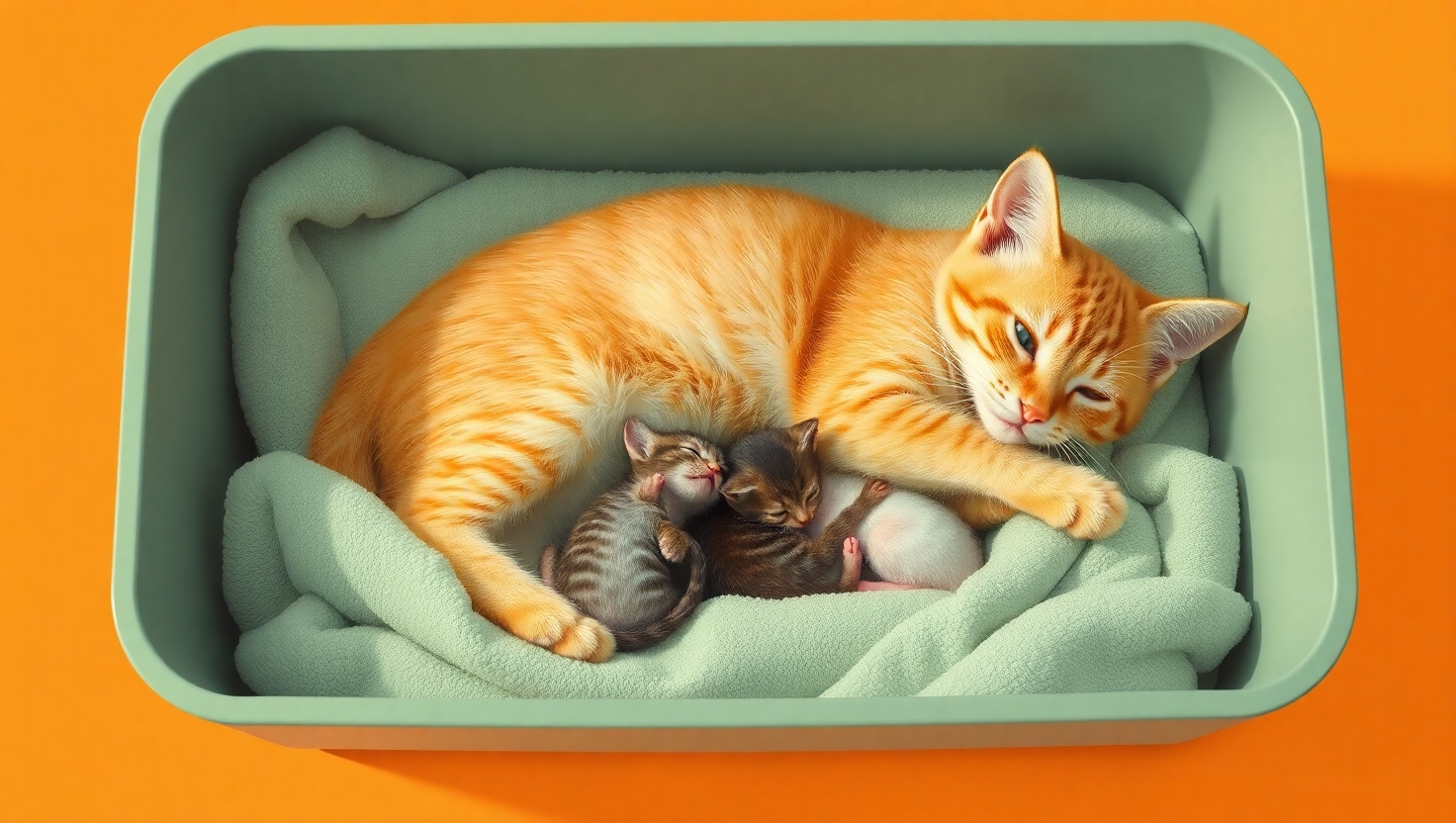
Ensure Kittens Are Dry and Nursing
After the delivery, the kittens should be warm, dry, and nursing actively. The mom usually does this without the need for assistance; she gently licks the kittens and carries them from the birth area to feed. But if the mother is too tired or confused, then you may need to roll the kittens onto a soft towel to dry or dry them with a towel and assist them to a nipple.
Replace Soiled Bedding Without Disturbing the Family
Keep the nesting area as clean as possible by removing soiled towels or bedding with care and avoiding movement of the mother or kittens whenever possible. Clean regions can reduce the risk of infections and keep the kittens warm and dry.
Monitor for Excessive Bleeding or Retained Placenta
After giving birth, you’ll notice bleeding or discharge; some discharge is normal, but if the bleeding is excessive or there is a foul smell, it indicates a retained placenta or some other complication. A placenta follows each kitten. If it does not seem anywhere near, or you suspect that there might be one missing, consult with your veterinarian as soon as possible.
Provide Fresh Water and High-Calorie Food to Mom
While it seems obvious, a nursing mother requires a lot more calories in order to make milk. You can continue to feed her good quality kitten food with frequent feeding times. Make sure to give her access to fresh water at all times to help with hydration and milk production.
Maintain Proper Nest Temperature
Kittens are unable to self-regulate their body temperature during their first week of life. The nesting box should be kept at a temperature of 85–90°F (29–32°C). If needed, use heating pads or warm towels to maintain a warm environment, and remember to provide enough area for the mother and kittens to escape the heat if they become overly warm.
Caring for a pregnant cat doesn’t end at delivery; it becomes gentle, supportive postpartum care. By keeping the mother comfortable, well-fed, and healthy, you will provide the best beginning for both the kitten and the mother.
For more details on managing pregnancy in cats, you may read these detailed feline pregnancy management guidelines from petMd.
Caring for a Pregnant Cat Can Be Simple
Now, you’re familiar with all aspects of Caring for a pregnant cat, which takes attention, patience, and preparation. From recognizing signs of pregnancy to creating a calm environment for nesting, each step is essential in providing support for your cat’s health and well-being. Good nutrition, regular hydration, and consistent vet care will help ensure that both the mom and her kittens are going to do well on their pregnancy journey.
Providing a quiet, stress-free environment and understanding the signs of delivery when your cat is close to labor will make a huge difference. While most cats will go through the process naturally, it helps to be cognizant of the behaviors and be in a position to avert complications. With thorough care and creating a relaxing atmosphere for your cat, you will be giving everything she needs for a safe and successful delivery.
FAQs
At What Age Can a Cat First Get Pregnant?
Taking care of a pregnant cat first starts with knowing when it can even reproduce. A female cat can get pregnant as early as four months of age, but most would be in heat by five to six months old. Because the cycling female cat is called an induced ovulation, or in this case, ovulation can happen by mating with male cats. It means cats can get pregnant during their first heat cycle. It is crucial to spay female cats early enough; this is especially true in a multi-cat household or if it is allowed outside.
How Long Does Cat Labor Usually Take?
The labor period for cats typically lasts from 2 to 6 hours (depending upon the number of kittens and the health of the mother cat). A healthy queen usually delivers her kittens every 10 – 60 minutes. However, it is also normal for some cats to take a break of several hours between kittens if they are not straining and feel safe. If your cat has continued visible contractions for 20 minutes without progressing, a vet is needed.
How Can You Tell If a Cat Is Pregnant by Looking?
The most obvious signs of pregnancy in cats are a slowly growing belly, darkened and swollen nipples (often called “pinking up”), and slight changes in behavior (like increased affection or behavioral restlessness). Additionally, they will frequently groom the area around the stomach and increase grooming overall.
Is It Possible for a Nursing Cat to Get Pregnant Again?
Yes- female cats are seasonally polyestrous, which means they can have multiple cycles during their breeding season, even if they are currently nursing. Some queens can become pregnant again a few weeks after parturition. As kitten caregivers, you should separate pregnant or new mothers from intact males to prevent rebreeding; after the kittens are weaned, you should speak with your veterinarian about spaying her.
Conclusion
Providing care for a pregnant cat means more than just watching her belly grow; it means providing support, nutrition, a place to nest, and veterinary care. Your role involves your capacity to pay attention to your cat and help her become comfortable, from the earliest signs that she is pregnant to preparing for labor to caring for her after she has delivered her kittens. Your attention can mean everything to her and the health of her kittens.
Regardless of whether this is your first experience or you are increasing your feline family, knowing each phase of your cat’s pregnancy allows you to prepare for the next step. With routine and trusting veterinary advice, you can provide your expecting queen with enough support for a healthy, safe pregnancy and easy delivery.

